fuel Citroen C4 AIRCROSS RHD 2012 1.G Owner's Manual
[x] Cancel search | Manufacturer: CITROEN, Model Year: 2012, Model line: C4 AIRCROSS RHD, Model: Citroen C4 AIRCROSS RHD 2012 1.GPages: 332
Page 5 of 332
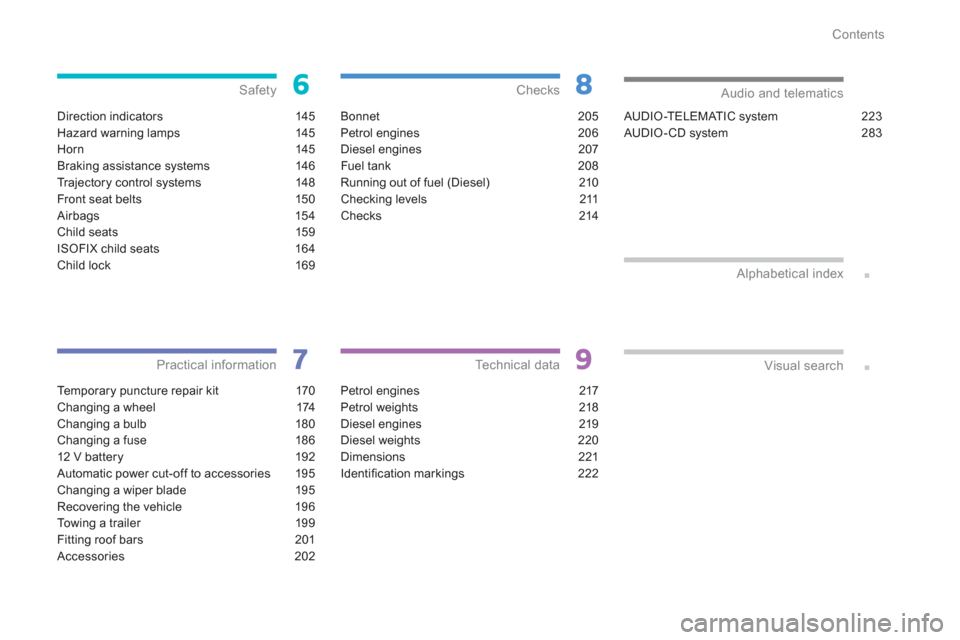
Contents
Direction indicators 145
Hazard warning lamps 145
Horn 145
Braking assistance systems 146
Tr ajectory control systems 148
Front seat belts 150
Airbags 154
Child seats 159
ISOFIX child seats 164
Child lock 169
Safety
Te m p o r a ry puncture repair kit 170
Changing a wheel 174
Changing a bulb 180
Changing a fuse 186
12 V battery 192
Automatic power cut-off to accessories 195
Changing a wiper blade 195
Recovering the vehicle 196
To w i ng a trailer 199
Fitting roof bars 201
Accessories 202
Practical information
Bonnet 205
Petrol engines 206
Diesel engines 207
Fuel tank 208
Running out of fuel (Diesel) 210
Checking levels 211
Checks 214
Checks
Petrol engines 217
Petrol weights 218
Diesel engines 219
Diesel weights 220
Dimensions 221
Identifi cation markings 222
Technical data
AUDIO-TELEMATIC system 223
AUDIO- CD system 283
Audio and telematics
Alphabetical index
Visual search
Page 6 of 332
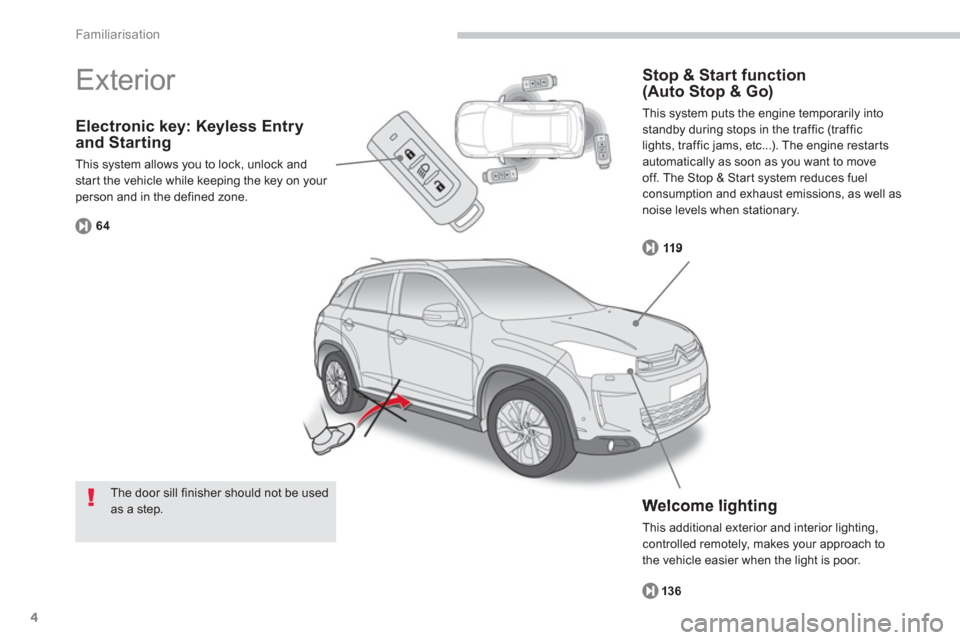
4
Familiarisation
Electronic key: Keyless Entryand Starting
This system allows you to lock, unlock andstart the vehicle while keeping the key on your person and in the defined zone.
6
4
Welcome lighting
This additional exterior and interior lighting, controlled remotely, makes your approach to
the vehicle easier when the light is poor.
13
6
Exterior
Stop & Start function(Auto Stop & Go)
This system puts the engine temporarily into standby during stops in the traffic (traffic
lights, traffic jams, etc...). The engine restarts
automaticall
y as soon as you want to move
off. The Stop & Star t system reduces fuel consumption and exhaust emissions, as well asnoise levels when stationary.
119
The door sill finisher should not be used as a step.
Page 9 of 332
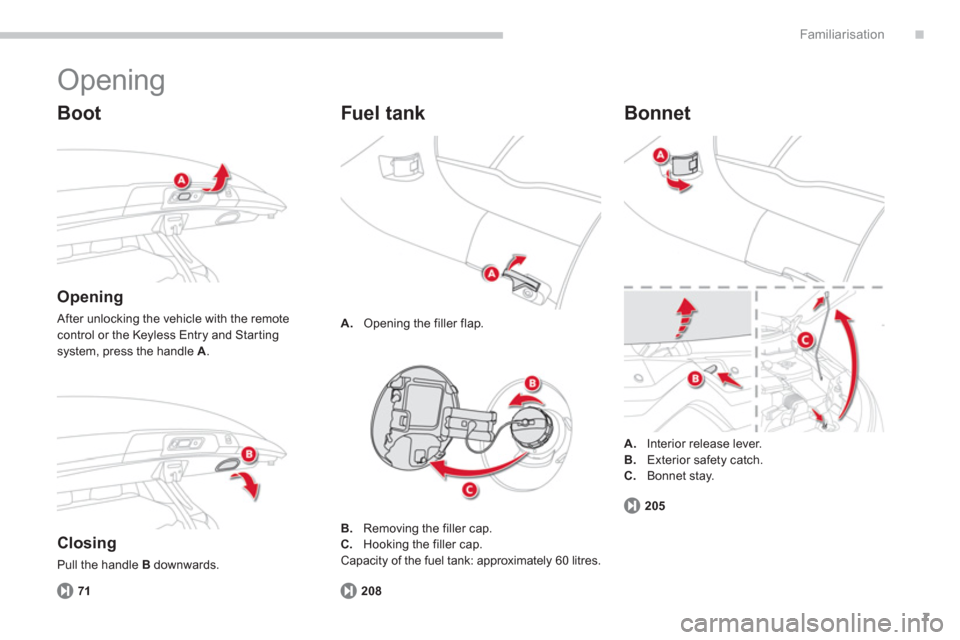
.
7
Familiarisation
Opening
Boot
Opening
After unlocking the vehicle with the remotecontrol or the Keyless Entry and Star ting system, press the handle A.
Closing
Pull the handle B
downwards.
Fuel t ank
A.
Opening the filler flap.
7
1208
B. Removing the filler cap.
C. Hooking the filler cap.
Capacity of the fuel tank: approximately 60 litres.
Bonnet
A.Interior release lever.
B. Exterior safety catch. C.
Bonnet stay.
205
Page 24 of 332
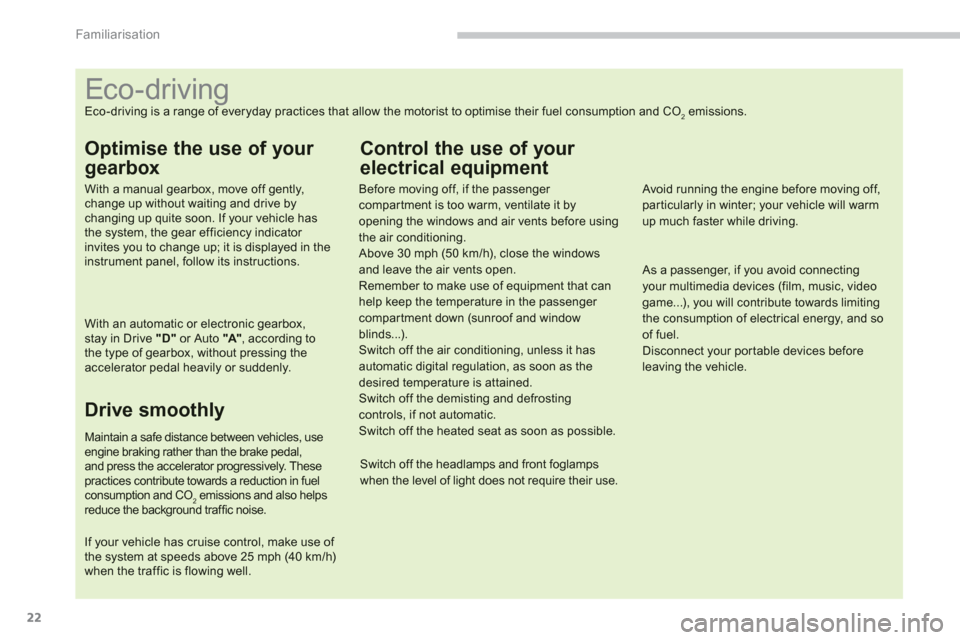
22
Familiarisation
Eco-driving
Eco-driving is a range of everyday practices that allow the motorist to optimise their fuel consumption and CO2emissions.
Optimise the use of your
gearbox
With a manual gearbox, move off gently,change up without waiting and drive by changing up quite soon. If your vehicle has the system, the gear efficiency indicator invites you to change up; it is displayed in the instrument panel, follow its instructions.
With an automatic or electronic gearbox, stay in Drive "D"or Auto "A"
, according to the type of gearbox, without pressing theaccelerator pedal heavily or suddenly.
Drive smoothly
Maintain a safe distance between vehicles, use engine braking rather than the brake pedal,and press the accelerator progressively. These practices contribute towards a reduction in fuelconsumption and CO2 emissions and also helpsreduce the background traffic noise.
If your vehicle has cruise control, make use of the system at speeds above 25 mph (40 km/h) when the traffic is flowing well.
Control the use of your
electrical equipment
Before moving off, if the passenger compartment is too warm, ventilate it byopening the windows and air vents before using
the air conditioning.
Above 30 mph (50 km/h), close the windows and leave the air vents open.
Remember to make use of equipment that canhelp keep the temperature in the passenger compartment down (sunroof and windowblinds...).
Switch off the air conditioning, unless it has automatic digital regulation, as soon as thedesired temperature is attained. Switch off the demisting and defrostingcontrols, if not automatic. Switch off the heated seat as soon as possible.
Switch off the headlamps and front foglampswhen the level of light does not require their use.
Avoid running the engine before moving off,particularly in winter; your vehicle will warmup much faster while driving.
As a passenger, if you avoid connecting your multimedia devices (film, music, videogame...), you will contribute towards limitingthe consumption of electrical energy, and soof fuel.
Disconnect your por table devices beforeleaving the vehicle.
Page 25 of 332
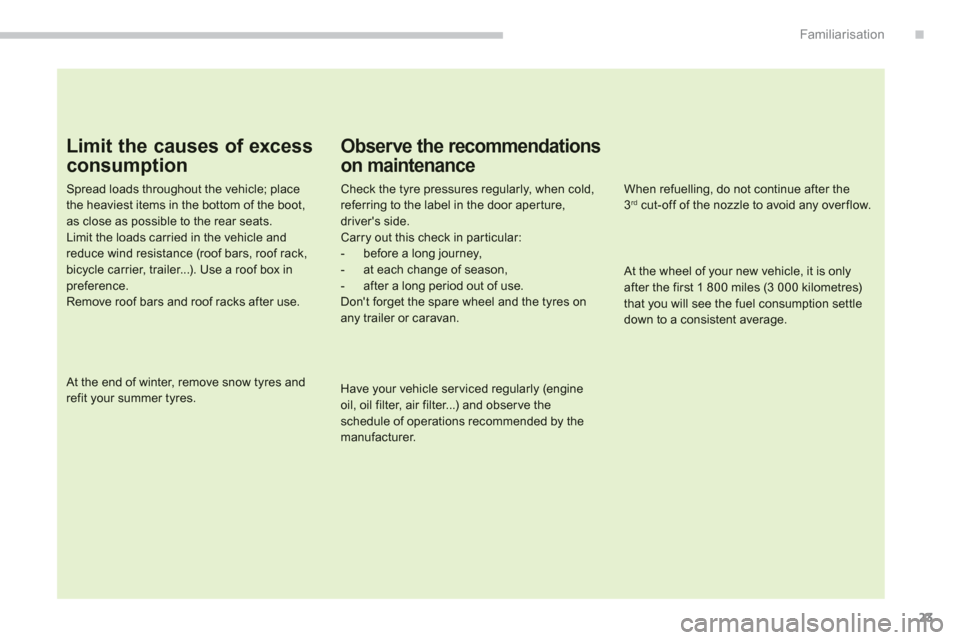
.
23
Familiarisation
Limit the causes of excess
consumption
Spread loads throughout the vehicle; placethe heaviest items in the bottom of the boot,as close as possible to the rear seats.Limit the loads carried in the vehicle and reduce wind resistance (roof bars, roof rack, bicycle carrier, trailer...). Use a roof box inpreference.Remove roof bars and roof racks after use.
At the end of winter, remove snow tyres and refit your summer tyres.
Observe the recommendations
on maintenance
Check the tyre pressures regularly, when cold, referring to the label in the door aper ture, driver's side.
Carry out this check in par ticular:- before a long journey,- at each change of season,- after a long period out of use. Don't forget the spare wheel and the tyres onany trailer or caravan.
Have your vehicle ser viced regularly (engine oil, oil filter, air filter...) and obser ve the schedule of operations recommended by themanufacturer.
When refuelling, do not continue after the3 rd
cut-off of the nozzle to avoid any over flow.
At the wheel of your new vehicle, it is only after the first 1 800 miles (3 000 kilometres) that you will see the fuel consumption settledown to a consistent average.
Page 26 of 332
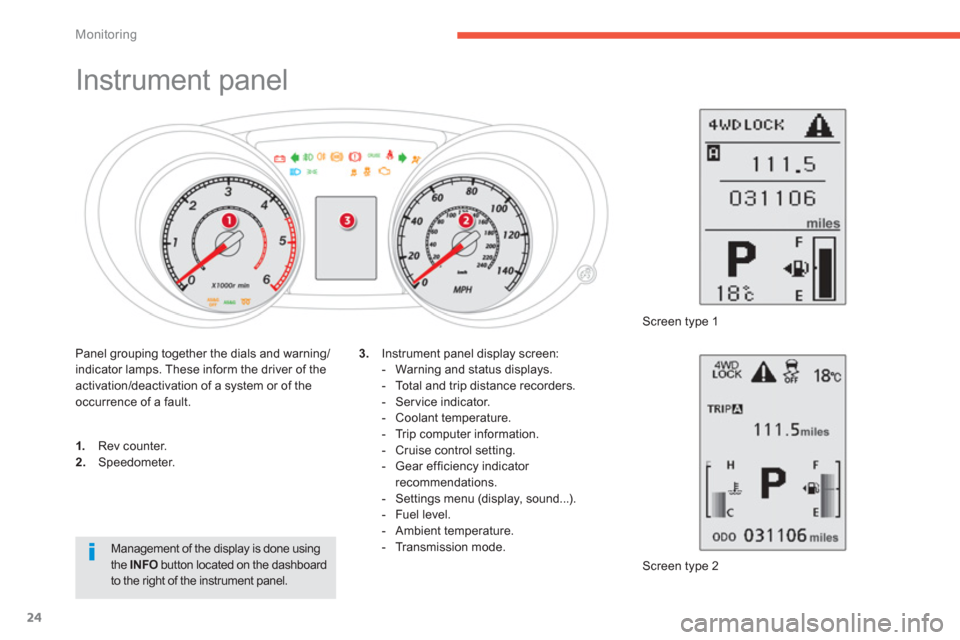
24
Monitoring
Instrument panel
1.
Rev counter. 2.
Speedometer.
Screen t
ype 2
3.
Instrument panel display screen:
- Warning and status displays.
- Total and tri
p distance recorders.
- Ser vice indicator.
- Coolant temperature.
- Trip computer information.
- Cruise control settin
g.
- Gear efficiency indicator
recommendations.
- Settings menu (display, sound...).
- Fuel level.
- Ambient temperature.
- Tr
ansmission mode.
Panel
grouping together the dials and warning/indicator lamps. These inform the driver of the activation/deactivation of a system or of theoccurrence of a fault.
Screen t
ype 1
Management of the display is done using the INFO
button located on the dashboard to the right of the instrument panel.
Page 39 of 332
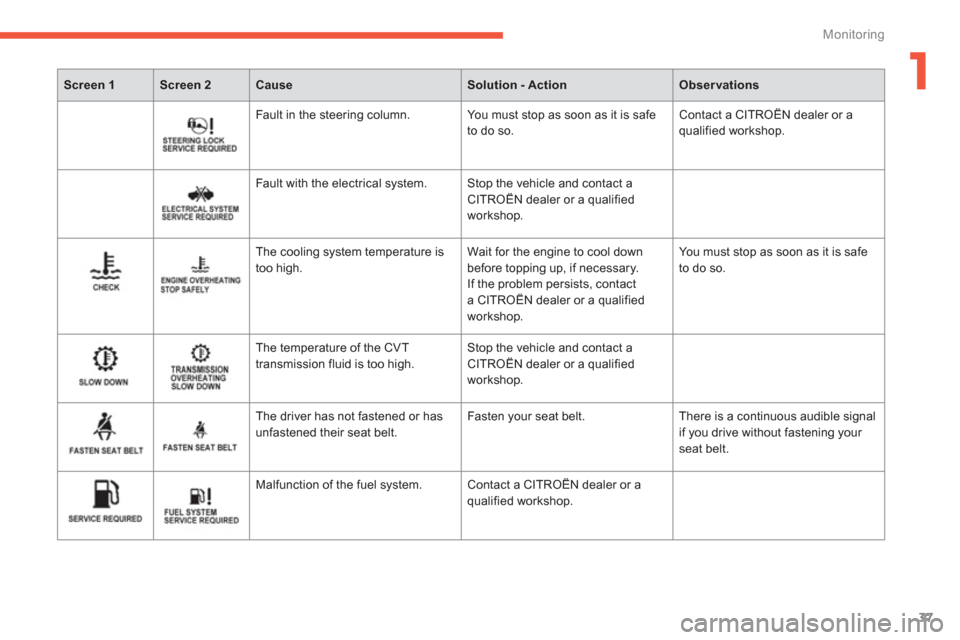
1
37
Monitoring
Screen 1Screen 2CauseSolution - ActionObservations
Fault in the steering column. You must stop as soon as it is safe
to do so. Contact a CITROËN dealer or a qualified workshop.
Fault with the electrical s
ystem. Stop the vehicle and contact aCITROËN dealer or a qualified workshop.
The cooling system temperature is
too hi
gh. Wait for the engine to cool downbefore topping up, if necessary.
If the problem persists, contact
a CITROËN dealer or a qualified
workshop. You must sto
p as soon as it is safe
to do so.
The temperature o
f the CVT
transmission fluid is too high. Stop the vehicle and contact aCITROËN dealer or a qualified workshop.
Th
e driver has not fastened or has unfastened their seat belt. Fasten your seat belt. There is a continuous audible signal
if you drive without fastening your seat belt.
Mal
function of the fuel system. Contact a CITROËN dealer or a qualified workshop.
Page 41 of 332
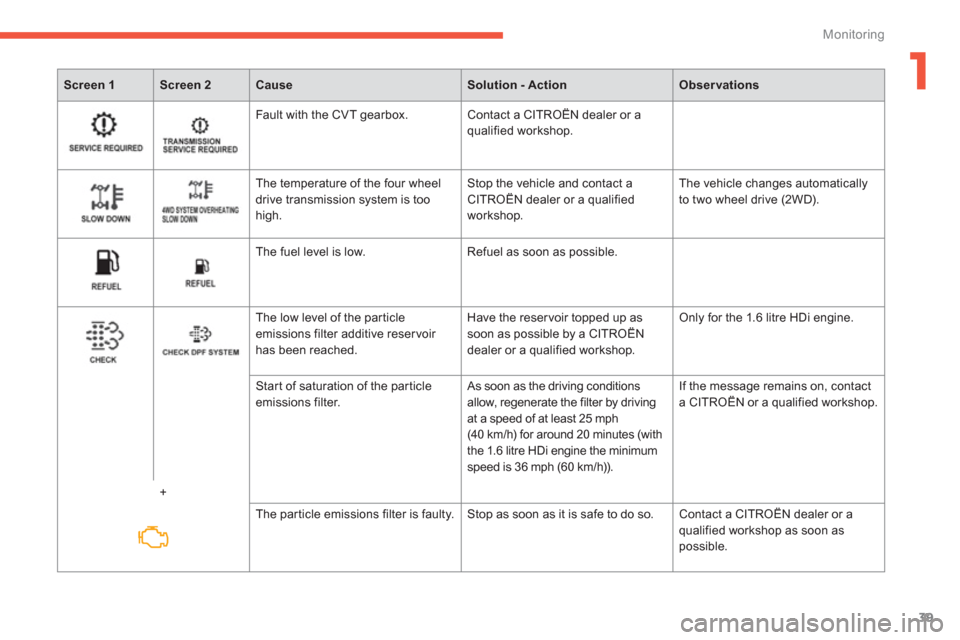
1
39
Monitoring
Screen 1Screen 2CauseSolution - ActionObservations
Fault with the CVT gearbox. Contact a CITROËN dealer or a qualified workshop.
The temperature of the four wheel
drive transmission system is toohigh. Stop the vehicle and contact aCITROËN dealer or a qualified workshop. The vehicle chan
ges automatically
to two wheel drive (2WD).
Th
e fuel level is low. Refuel as soon as possible.
The low level o
f the particleemissions filter additive reservoir has been reached.
Have the reser voir topped up as
soon as possible by a CITROËN
dealer or a quali
fied workshop.
Only for the 1.6 litre HDi engine.
+Star t of saturation of the par ticle
emissions filter. As soon as the driving conditions
allow, regenerate the filter by driving
at a speed of at least 25 mph
(40 km/h) for around 20 minutes (with
the 1.6 litre HDi engine the minimum
speed is 36 mph (60 km/h)). If the messa
ge remains on, contact
a CITROËN or a qualified workshop.
The par ticle emissions filter is fault
y. Stop as soon as it is safe to do so. Contact a CITROËN dealer or a qualified workshop as soon as
possible.
Page 42 of 332
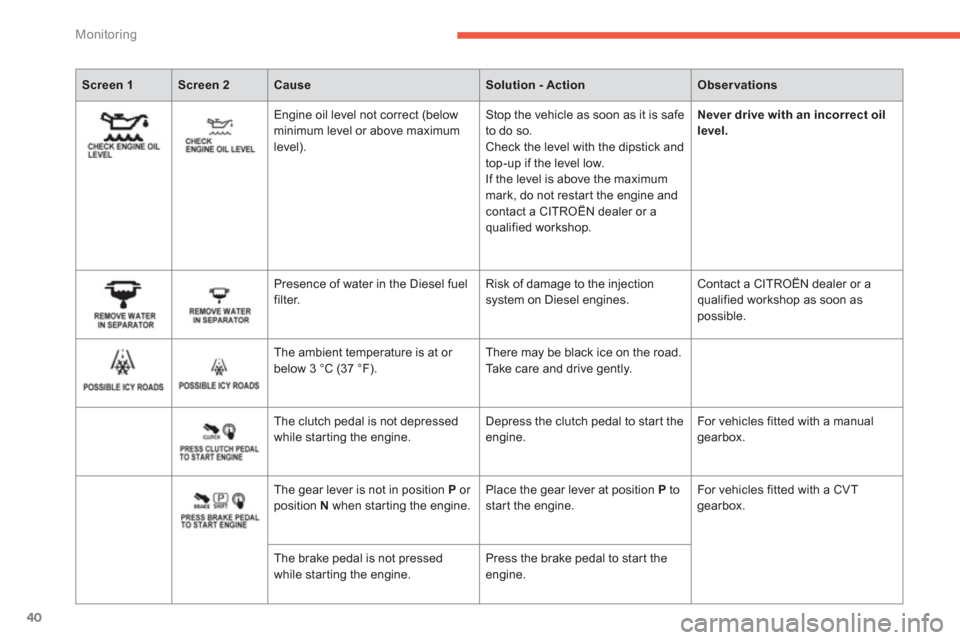
40
Monitoring
Screen 1Screen 2CauseSolution - ActionObservations
Engine oil level not correct (below minimum level or above maximum level). Stop the vehicle as soon as it is safe
to do so.
Check the level with the dipstick and
top-up if the level low.
I
f the level is above the maximum
mark, do not restar t the engine andcontact a CITROËN dealer or aqualified workshop. Never drive with an incorrect oil
level.
Presence of water in the Diesel fuel filter. Risk of damage to the injection system on Diesel engines. Contact a CITROËN dealer or aqualified workshop as soon as possible.
The ambient temperature is at or
below 3 °C
(37 °F). There may be black ice on the road.
Take care and drive gently.
The clutch pedal is not depressed
while star tin
g the engine. Depress the clutch pedal to star t theengine. For vehicles fitted with a manual gearbox.
The gear lever is not in position P
or position N
when starting the engine. Place the gear lever at position P tostart the engine. For vehicles fitted with a CVT gearbox.
The brake
pedal is not pressed
while star ting the engine. Press the brake pedal to star t theengine.
Page 45 of 332
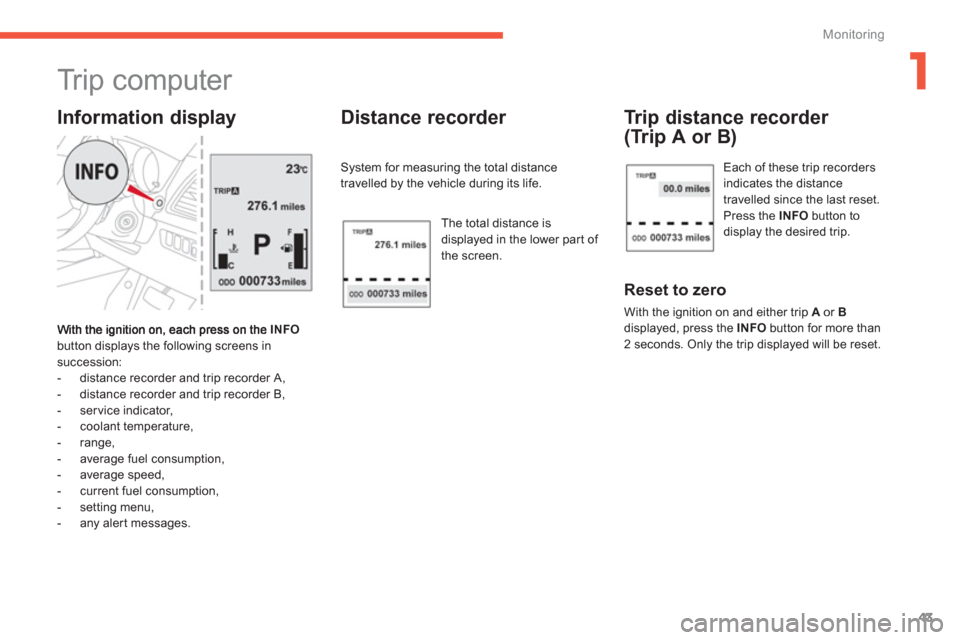
1
43
Monitoring
Tr i p c o m p u t e r
INFO
button displays the following screens in succession:
- distance recorder and trip recorder A,
- distance recorder and trip recorder B,
- service indicator,
- coolant temperature,
- range,
- average fuel consumption,
- average speed,
- current fuel consumption,
- settin
g menu,
- any aler t messages.
Information display Distance recorder
System for measuring the total distance
travelled by the vehicle during its life.
Th
e total distance is
displayed in the lower part of
the screen.
Trip distance recorder
(Trip A or B)
Reset to zero
With the ignition on and either trip Aor Bdisplayed, press the INFObutton for more than
2 seconds. Only the trip displayed will be reset.
Each of these trip recordersindicates the distance
travelled since the last reset.
Press the INFObutton todisplay the desired trip.